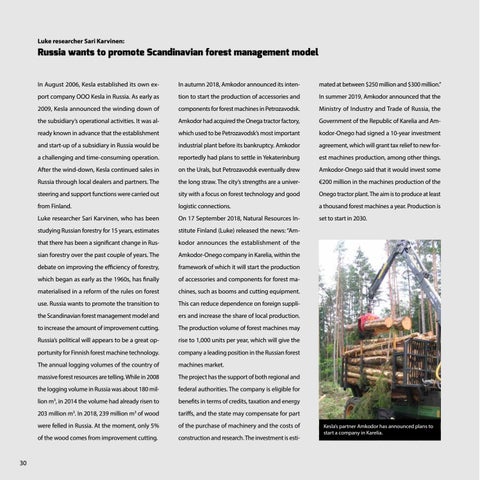Luke researcher Sari Karvinen:
Russia wants to promote Scandinavian forest management model
30
In August 2006, Kesla established its own ex-
In autumn 2018, Amkodor announced its inten-
mated at between $250 million and $300 million.”
port company OOO Kesla in Russia. As early as
tion to start the production of accessories and
In summer 2019, Amkodor announced that the
2009, Kesla announced the winding down of
components for forest machines in Petrozavodsk.
Ministry of Industry and Trade of Russia, the
the subsidiary’s operational activities. It was al-
Amkodor had acquired the Onega tractor factory,
Government of the Republic of Karelia and Am-
ready known in advance that the establishment
which used to be Petrozavodsk’s most important
kodor-Onego had signed a 10-year investment
and start-up of a subsidiary in Russia would be
industrial plant before its bankruptcy. Amkodor
agreement, which will grant tax relief to new for-
a challenging and time-consuming operation.
reportedly had plans to settle in Yekaterinburg
est machines production, among other things.
After the wind-down, Kesla continued sales in
on the Urals, but Petrozavodsk eventually drew
Amkodor-Onego said that it would invest some
Russia through local dealers and partners. The
the long straw. The city’s strengths are a univer-
€200 million in the machines production of the
steering and support functions were carried out
sity with a focus on forest technology and good
Onego tractor plant. The aim is to produce at least
from Finland.
logistic connections.
a thousand forest machines a year. Production is
Luke researcher Sari Karvinen, who has been
On 17 September 2018, Natural Resources In-
set to start in 2030.
studying Russian forestry for 15 years, estimates
stitute Finland (Luke) released the news: “Am-
that there has been a significant change in Rus-
kodor announces the establishment of the
sian forestry over the past couple of years. The
Amkodor-Onego company in Karelia, within the
debate on improving the efficiency of forestry,
framework of which it will start the production
which began as early as the 1960s, has finally
of accessories and components for forest ma-
materialised in a reform of the rules on forest
chines, such as booms and cutting equipment.
use. Russia wants to promote the transition to
This can reduce dependence on foreign suppli-
the Scandinavian forest management model and
ers and increase the share of local production.
to increase the amount of improvement cutting.
The production volume of forest machines may
Russia’s political will appears to be a great op-
rise to 1,000 units per year, which will give the
portunity for Finnish forest machine technology.
company a leading position in the Russian forest
The annual logging volumes of the country of
machines market.
massive forest resources are telling. While in 2008
The project has the support of both regional and
the logging volume in Russia was about 180 mil-
federal authorities. The company is eligible for
lion m3, in 2014 the volume had already risen to
benefits in terms of credits, taxation and energy
203 million m3. In 2018, 239 million m3 of wood
tariffs, and the state may compensate for part
were felled in Russia. At the moment, only 5%
of the purchase of machinery and the costs of
of the wood comes from improvement cutting.
construction and research. The investment is esti-
Kesla’s partner Amkodor has announced plans to start a company in Karelia.






























